Analysis of Ozone Formation Sensitivity in Chinese Representative Regions Using Satellite and Ground-Based Data
Abstract
1. Introduction
2. Materials and Methods
2.1. Study Areas
2.2. Data
2.2.1. Satellite Data: TROPOMI Data
2.2.2. Ground-Based Data
2.3. Methods
3. Results
3.1. Variation Pattern of O3 and Its Precursors
3.1.1. Analysis of O3 pollution
3.1.2. Analysis of NO2 and HCHO Pollution
3.2. Regional and Seasonal Differences in FNR
3.3. Determination and Analysis of FNR Thresholds for Ozone Precursors in Representative Areas
3.4. Spatial and Temporal Analysis of O3 Control Regimes
4. Discussion
5. Conclusions
Author Contributions
Funding
Data Availability Statement
Acknowledgments
Conflicts of Interest
References
- Nuvolone, D.; Petri, D.; Voller, F. The Effects of Ozone on Human Health. Environ. Sci. Pollut. Res. 2018, 25, 8074–8088. [Google Scholar] [CrossRef] [PubMed]
- Norval, M.; Cullen, A.P.; De Gruijl, F.R.; Longstreth, J.; Takizawa, Y.; Lucas, R.M.; Noonan, F.P.; Van Der Leun, J.C. The Effects on Human Health from Stratospheric Ozone Depletion and Its Interactions with Climate Change. Photochem. Photobiol. Sci. 2007, 6, 232–251. [Google Scholar] [CrossRef] [PubMed]
- Zhao, F.; Liu, C.; Cai, Z.; Liu, X.; Bak, J.; Kim, J.; Hu, Q.; Xia, C.; Zhang, C.; Sun, Y.; et al. Ozone Profile Retrievals from TROPOMI: Implication for the Variation of Tropospheric Ozone during the Outbreak of COVID-19 in China. Sci. Total Environ. 2021, 764, 142886. [Google Scholar] [CrossRef] [PubMed]
- Haagen-Smit, A.J. Chemistry and Physiology of Los Angeles Smog. Ind. Eng. Chem. 1952, 44, 1342–1346. [Google Scholar] [CrossRef]
- Feng, Y.; Ning, M.; Lei, Y.; Sun, Y.; Liu, W.; Wang, J. Defending Blue Sky in China: Effectiveness of the “Air Pollution Prevention and Control Action Plan” on Air Quality Improvements from 2013 to 2017. J. Environ. Manag. 2019, 252, 109603. [Google Scholar] [CrossRef] [PubMed]
- Liu, C.; Xing, C.; Hu, Q.; Li, Q.; Liu, H.; Hong, Q.; Tan, W.; Ji, X.; Lin, H.; Lu, C.; et al. Ground-Based Hyperspectral Stereoscopic Remote Sensing Network: A Promising Strategy to Learn Coordinated Control of O3 and PM2.5 over China. Engineering 2022, 19, 71–83. [Google Scholar] [CrossRef]
- Wang, T.; Xue, L.; Brimblecombe, P.; Lam, Y.F.; Li, L.; Zhang, L. Ozone Pollution in China: A Review of Concentrations, Meteorological Influences, Chemical Precursors, and Effects. Sci. Total Environ. 2017, 575, 1582–1596. [Google Scholar] [CrossRef]
- Nguyen, D.-H.; Lin, C.; Vu, C.-T.; Cheruiyot, N.K.; Nguyen, M.K.; Le, T.H.; Lukkhasorn, W.; Vo, T.-D.-H.; Bui, X.-T. Tropospheric Ozone and NOx: A Review of Worldwide Variation and Meteorological Influences. Environ. Technol. Innov. 2022, 28, 102809. [Google Scholar] [CrossRef]
- Lal, S.; Naja, M.; Subbaraya, B.H. Seasonal Variations in Surface Ozone and Its Precursors over an Urban Site in India. Atmos. Environ. 2000, 34, 2713–2724. [Google Scholar] [CrossRef]
- Sillman, S. Some Theoretical Results Concerning O3-NOx-VOC Chemistry and NOx-VOC Indicators. J. Geophys. Res. 2002, 107, 4659. [Google Scholar] [CrossRef]
- Wang, X.; Yin, S.; Zhang, R.; Yuan, M.; Ying, Q. Assessment of Summertime O3 Formation and the O3-NOx-VOC Sensitivity in Zhengzhou, China Using an Observation-Based Model. Sci. Total Environ. 2022, 813, 152449. [Google Scholar] [CrossRef]
- Choi, Y.; Kim, H.; Tong, D.; Lee, P. Summertime Weekly Cycles of Observed and Modeled NOx and O3 Concentrations as a Function of Satellite-Derived Ozone Production Sensitivity and Land Use Types over the Continental United States. Atmos. Chem. Phys. 2012, 12, 6291–6307. [Google Scholar] [CrossRef]
- Sun, J.; Shen, Z.; Wang, R.; Li, G.; Zhang, Y.; Zhang, B.; He, K.; Tang, Z.; Xu, H.; Qu, L.; et al. A Comprehensive Study on Ozone Pollution in a Megacity in North China Plain during Summertime: Observations, Source Attributions and Ozone Sensitivity. Environ. Int. 2021, 146, 106279. [Google Scholar] [CrossRef] [PubMed]
- Xie, M.; Zhu, K.; Wang, T.; Yang, H.; Zhuang, B.; Li, S.; Li, M.; Zhu, X.; Ouyang, Y. Application of Photochemical Indicators to Evaluate Ozone Nonlinear Chemistry and Pollution Control Countermeasure in China. Atmos. Environ. 2014, 99, 466–473. [Google Scholar] [CrossRef]
- Sillman, S. The Use of NOy, H2O2, and HNO3 as Indicators for Ozone-NOx-Hydrocarbon Sensitivity in Urban Locations. J. Geophys. Res. 1995, 100, 14175. [Google Scholar] [CrossRef]
- Tonnesen, G.S.; Dennis, R.L. Analysis of Radical Propagation Efficiency to Assess Ozone Sensitivity to Hydrocarbons and NOx: 1. Local Indicators of Instantaneous Odd Oxygen Production Sensitivity. J. Geophys. Res. Atmos. 2000, 105, 9213–9225. [Google Scholar] [CrossRef]
- Liu, J.; Li, X.; Tan, Z.; Wang, W.; Yang, Y.; Zhu, Y.; Yang, S.; Song, M.; Chen, S.; Wang, H.; et al. Assessing the Ratios of Formaldehyde and Glyoxal to NO2 as Indicators of O3–NOx–VOC Sensitivity. Environ. Sci. Technol. 2021, 55, 10935–10945. [Google Scholar] [CrossRef]
- Martin, R.V.; Fiore, A.M.; Van Donkelaar, A. Space-Based Diagnosis of Surface Ozone Sensitivity to Anthropogenic Emissions: Surface Ozone Sensitivity to Emissions. Geophys. Res. Lett. 2004, 31, L06120. [Google Scholar] [CrossRef]
- Duncan, B.N.; Yoshida, Y.; Olson, J.R.; Sillman, S.; Martin, R.V.; Lamsal, L.; Hu, Y.; Pickering, K.E.; Retscher, C.; Allen, D.J.; et al. Application of OMI Observations to a Space-Based Indicator of NOx and VOC Controls on Surface Ozone Formation. Atmos. Environ. 2010, 44, 2213–2223. [Google Scholar] [CrossRef]
- Jin, X.; Fiore, A.; Boersma, K.F.; Smedt, I.D.; Valin, L. Inferring Changes in Summertime Surface Ozone–NOx–VOC Chemistry over U.S. Urban Areas from Two Decades of Satellite and Ground-Based Observations. Environ. Sci. Technol. 2020, 54, 6518–6529. [Google Scholar] [CrossRef]
- Wang, W.; van der A, R.; Ding, J.; van Weele, M.; Cheng, T. Spatial and Temporal Changes of the Ozone Sensitivity in China Based on Satellite and Ground-Based Observations. Atmos. Chem. Phys. 2021, 21, 7253–7269. [Google Scholar] [CrossRef]
- Choi, Y.; Souri, A.H. Chemical Condition and Surface Ozone in Large Cities of Texas during the Last Decade: Observational Evidence from OMI, CAMS, and Model Analysis. Remote Sens. Environ. 2015, 168, 90–101. [Google Scholar] [CrossRef]
- Jin, X.; Holloway, T. Spatial and Temporal Variability of Ozone Sensitivity over China Observed from the Ozone Monitoring Instrument: Ozone Sensitivity over China. J. Geophys. Res. Atmos. 2015, 120, 7229–7246. [Google Scholar] [CrossRef]
- Witte, J.C.; Duncan, B.N.; Douglass, A.R.; Kurosu, T.P.; Chance, K.; Retscher, C. The Unique OMI HCHO/NO2 Feature during the 2008 Beijing Olympics: Implications for Ozone Production Sensitivity. Atmos. Environ. 2011, 45, 3103–3111. [Google Scholar] [CrossRef]
- Chen, Y.; Yan, H.; Yao, Y.; Zeng, C.; Gao, P.; Zhuang, L.; Fan, L.; Ye, D. Relationships of Ozone Formation Sensitivity with Precursors Emissions, Meteorology and Land Use Types, in Guangdong-Hong Kong-Macao Greater Bay Area, China. J. Environ. Sci. 2020, 94, 1–13. [Google Scholar] [CrossRef] [PubMed]
- Sun, Y.; Liu, C.; Palm, M.; Vigouroux, C.; Notholt, J.; Hu, Q.; Jones, N.; Wang, W.; Su, W.; Zhang, W.; et al. Ozone Seasonal Evolution and Photochemical Production Regime in the Polluted Troposphere in Eastern China Derived from High-Resolution Fourier Transform Spectrometry (FTS) Observations. Atmos. Chem. Phys. 2018, 18, 14569–14583. [Google Scholar] [CrossRef]
- Li, Y.; Yin, S.; Yu, S.; Bai, L.; Wang, X.; Lu, X.; Ma, S. Characteristics of Ozone Pollution and the Sensitivity to Precursors during Early Summer in Central Plain, China. J. Environ. Sci. 2021, 99, 354–368. [Google Scholar] [CrossRef]
- Lu, C.; Chang, J.S. On the Indicator-based Approach to Assess Ozone Sensitivities and Emissions Features. J. Geophys. Res. Atmos. 1998, 103, 3453–3462. [Google Scholar] [CrossRef]
- Sun, H.Z.; Zhao, J.; Liu, X.; Qiu, M.; Shen, H.; Guillas, S.; Giorio, C.; Staniaszek, Z.; Yu, P.; Wan, M.W.L.; et al. Antagonism between Ambient Ozone Increase and Urbanization-Oriented Population Migration on Chinese Cardiopulmonary Mortality. Innovation 2023, 4, 100517. [Google Scholar] [CrossRef]
- De Smedt, I.; Pinardi, G.; Vigouroux, C.; Compernolle, S.; Bais, A.; Benavent, N.; Boersma, F.; Chan, K.-L.; Donner, S.; Eichmann, K.-U.; et al. Comparative Assessment of TROPOMI and OMI Formaldehyde Observations and Validation against MAX-DOAS Network Column Measurements. Atmos. Chem. Phys. 2021, 21, 12561–12593. [Google Scholar] [CrossRef]
- Huang, G.; Sun, K. Non-Negligible Impacts of Clean Air Regulations on the Reduction of Tropospheric NO2 over East China during the COVID-19 Pandemic Observed by OMI and TROPOMI. Sci. Total Environ. 2020, 745, 141023. [Google Scholar] [CrossRef] [PubMed]
- Van Geffen, J.; Eskes, H.; Compernolle, S.; Pinardi, G.; Verhoelst, T.; Lambert, J.-C.; Sneep, M.; Ter Linden, M.; Lu-dewig, A.; Boersma, K.F.; et al. Sentinel-5P TROPOMI NO2 Retrieval: Impact of Version v2.2 Improvements and Comparisons with OMI and Ground-Based Data. Atmos. Meas. Tech. 2022, 15, 2037–2060. [Google Scholar] [CrossRef]
- Shikwambana, L.; Mhangara, P.; Mbatha, N. Trend Analysis and First Time Observations of Sulphur Dioxide and Nitrogen Dioxide in South Africa Using TROPOMI/Sentinel-5 P Data. Int. J. Appl. Earth Obs. Geoinf. 2020, 91, 102130. [Google Scholar] [CrossRef]
- Veefkind, J.P.; Aben, I.; McMullan, K.; Förster, H.; de Vries, J.; Otter, G.; Claas, J.; Eskes, H.J.; de Haan, J.F.; Kleipool, Q.; et al. TROPOMI on the ESA Sentinel-5 Precursor: A GMES Mission for Global Observations of the Atmospheric Composition for Climate, Air Quality and Ozone Layer Applications. Remote Sens. Environ. 2012, 120, 70–83. [Google Scholar] [CrossRef]
- Vigouroux, C.; Langerock, B.; Bauer Aquino, C.A.; Blumenstock, T.; Cheng, Z.; De Mazière, M.; De Smedt, I.; Grutter, M.; Hannigan, J.W.; Jones, N.; et al. TROPOMI–Sentinel-5 Precursor Formaldehyde Validation Using an Extensive Network of Ground-Based Fourier-Transform Infrared Stations. Atmos. Meas. Tech. 2020, 13, 3751–3767. [Google Scholar] [CrossRef]
- Verhoelst, T.; Compernolle, S.; Pinardi, G.; Lambert, J.-C.; Eskes, H.J.; Eichmann, K.-U.; Fjæraa, A.M.; Granville, J.; Niemeijer, S.; Cede, A.; et al. Ground-Based Validation of the Copernius Sentinel-5P TROPOMI NO2 Measurements with the NDACC ZSL-DOAS, MAX-DOAS and Pandonia Global Networks. Atmos. Meas. Tech. 2021, 14, 481–510. [Google Scholar] [CrossRef]
- Copernicus Sentinel Data Processed by ESA, German Aerospace Center (DLR) (2020), Sentinel-5P TROPOMI Tropospheric Formaldehyde HCHO 1-Orbit L2 5.5 km × 3.5 km, Greenbelt, MD, USA, Goddard Earth Sciences Data and Information Services Center (GES DISC), 10.5270/S5P-vg1i7t0. Available online: https://disc.gsfc.nasa.gov/datasets/S5P_L2__HCHO___HiR_2/summary (accessed on 9 August 2023).
- Copernicus Sentinel data processed by ESA, Koninklijk Nederlands Meteorologisch Instituut (KNMI) (2021), Sentinel-5P TROPOMI Tropospheric NO2 1-Orbit L2 5.5 km × 3.5 km, Greenbelt, MD, USA, Goddard Earth Sciences Data and Information Services Center (GES DISC), 10.5270/S5P-9bnp8q8. Available online: https://disc.gsfc.nasa.gov/datasets/S5P_L2__NO2____HiR_2/summary (accessed on 9 August 2023).
- Zhang, Y.-L.; Cao, F. Fine Particulate Matter (PM2.5) in China at a City Level. Sci. Rep. 2015, 5, 14884. [Google Scholar] [CrossRef]
- Zhang, C.; Liu, C.; Li, B.; Zhao, F.; Zhao, C. Spatiotemporal Neural Network for Estimating Surface NO2 Concentrations over North China and Their Human Health Impact. Environ. Pollut. 2022, 307, 119510. [Google Scholar] [CrossRef]
- Lin, H.; Xing, C.; Hong, Q.; Liu, C.; Ji, X.; Liu, T.; Lin, J.; Lu, C.; Tan, W.; Li, Q.; et al. Diagnosis of Ozone Formation Sensitivities in Different Height Layers via MAX-DOAS Observations in Guangzhou. J. Geophys. Res. Atmos. 2022, 127, e2022JD036803. [Google Scholar] [CrossRef]
- Zhang, K.; Li, L.; Huang, L.; Wang, Y.; Huo, J.; Duan, Y.; Wang, Y.; Fu, Q. The Impact of Volatile Organic Compounds on Ozone Formation in the Suburban Area of Shanghai. Atmos. Environ. 2020, 232, 117511. [Google Scholar] [CrossRef]
- Han, S.; Bian, H.; Feng, Y.; Liu, A.; Li, X.; Zeng, F.; Zhang, X. Analysis of the Relationship between O3, NO and NO2 in Tianjin, China. Aerosol Air Qual. Res. 2011, 11, 128–139. [Google Scholar] [CrossRef]
- Li, P.; De Marco, A.; Feng, Z.; Anav, A.; Zhou, D.; Paoletti, E. Nationwide Ground-Level Ozone Measurements in China Suggest Serious Risks to Forests. Environ. Pollut. 2018, 237, 803–813. [Google Scholar] [CrossRef] [PubMed]
- GB3095-2012; Ambient Air Quality Standard. Ministry of Ecology and Environment of the People’s Republic of China: Beijing, China, 2012. (In Chinese)
- Wang, W.; Parrish, D.D.; Wang, S.; Bao, F.; Ni, R.; Li, X.; Yang, S.; Wang, H.; Cheng, Y.; Su, H. Long-Term Trend of Ozone Pollution in China during 2014–2020: Distinct Seasonal and Spatial Characteristics and Ozone Sensitivity. Atmos. Chem. Phys. 2022, 22, 8935–8949. [Google Scholar] [CrossRef]
- Yang, G.; Liu, Y.; Li, X. Spatiotemporal Distribution of Ground-Level Ozone in China at a City Level. Sci. Rep. 2020, 10, 7229. [Google Scholar] [CrossRef] [PubMed]
- Shen, H.; Sun, Z.; Chen, Y.; Russell, A.G.; Hu, Y.; Odman, M.T.; Qian, Y.; Archibald, A.T.; Tao, S. Novel Method for Ozone Isopleth Construction and Diagnosis for the Ozone Control Strategy of Chinese Cities. Environ. Sci. Technol. 2021, 55, 15625–15636. [Google Scholar] [CrossRef]
- Li, X.-B.; Yuan, B.; Parrish, D.D.; Chen, D.; Song, Y.; Yang, S.; Liu, Z.; Shao, M. Long-Term Trend of Ozone in Southern China Reveals Future Mitigation Strategy for Air Pollution. Atmos. Environ. 2022, 269, 118869. [Google Scholar] [CrossRef]
- Xu, Z.; Zou, Q.; Jin, L.; Shen, Y.; Shen, J.; Xu, B.; Qu, F.; Zhang, F.; Xu, J.; Pei, X.; et al. Characteristics and Sources of Ambient Volatile Organic Compounds (VOCs) at a Regional Background Site, YRD Region, China: Significant Influence of Solvent Evaporation during Hot Months. Sci. Total Environ. 2023, 857, 159674. [Google Scholar] [CrossRef]
- Yang, J.; Kang, S.; Ji, Z.; Yin, X.; Tripathee, L. Investigating Air Pollutant Concentrations, Impact Factors, and Emission Control Strategies in Western China by Using a Regional Climate-Chemistry Model. Chemosphere 2020, 246, 125767. [Google Scholar] [CrossRef]
- Zhang, H.; Wang, Y.; Hu, J.; Ying, Q.; Hu, X.-M. Relationships between Meteorological Parameters and Criteria Air Pollutants in Three Megacities in China. Environ. Res. 2015, 140, 242–254. [Google Scholar] [CrossRef]
- Jin, L.; Berman, J.D.; Zhang, Y.; Thurston, G.; Zhang, Y.; Bell, M.L. Land Use Regression Study in Lanzhou, China: A Pilot Sampling and Spatial Characteristics of Pilot Sampling Sites. Atmos. Environ. 2019, 210, 253–262. [Google Scholar] [CrossRef]
- Liu, Y.; Zhao, J.; Song, K.; Cheng, C.; Li, S.; Cai, K. Spatiotemporal Evolution Analysis of NO2 Column Density before and after COVID-19 Pandemic in Henan Province Based on SI-APSTE Model. Sci. Rep. 2021, 11, 18614. [Google Scholar] [CrossRef] [PubMed]
- Tang, G.; Zhang, J.; Zhu, X.; Song, T.; Münkel, C.; Hu, B.; Schäfer, K.; Liu, Z.; Zhang, J.; Wang, L.; et al. Mixing Layer Height and Its Implications for Air Pollution over Beijing, China. Atmos. Chem. Phys. 2016, 16, 2459–2475. [Google Scholar] [CrossRef]
- Wagner, P.; Schäfer, K. Influence of Mixing Layer Height on Air Pollutant Concentrations in an Urban Street Canyon. Urban Clim. 2017, 22, 64–79. [Google Scholar] [CrossRef]
- Chen, Y.; Wang, M.; Yao, Y.; Zeng, C.; Zhang, W.; Yan, H.; Gao, P.; Fan, L.; Ye, D. Research on the Ozone Formation Sensitivity Indicator of Four Urban Agglomerations of China Using Ozone Monitoring Instrument (OMI) Satellite Data and Ground-Based Measurements. Sci. Total Environ. 2023, 869, 161679. [Google Scholar] [CrossRef]
- Chan, K.L.; Wiegner, M.; van Geffen, J.; De Smedt, I.; Alberti, C.; Cheng, Z.; Ye, S.; Wenig, M. MAX-DOAS Measurements of Tropospheric NO2 and HCHO in Munich and the Comparison to OMI and TROPOMI Satellite Observations. Atmos. Meas. Tech. 2020, 13, 4499–4520. [Google Scholar] [CrossRef]

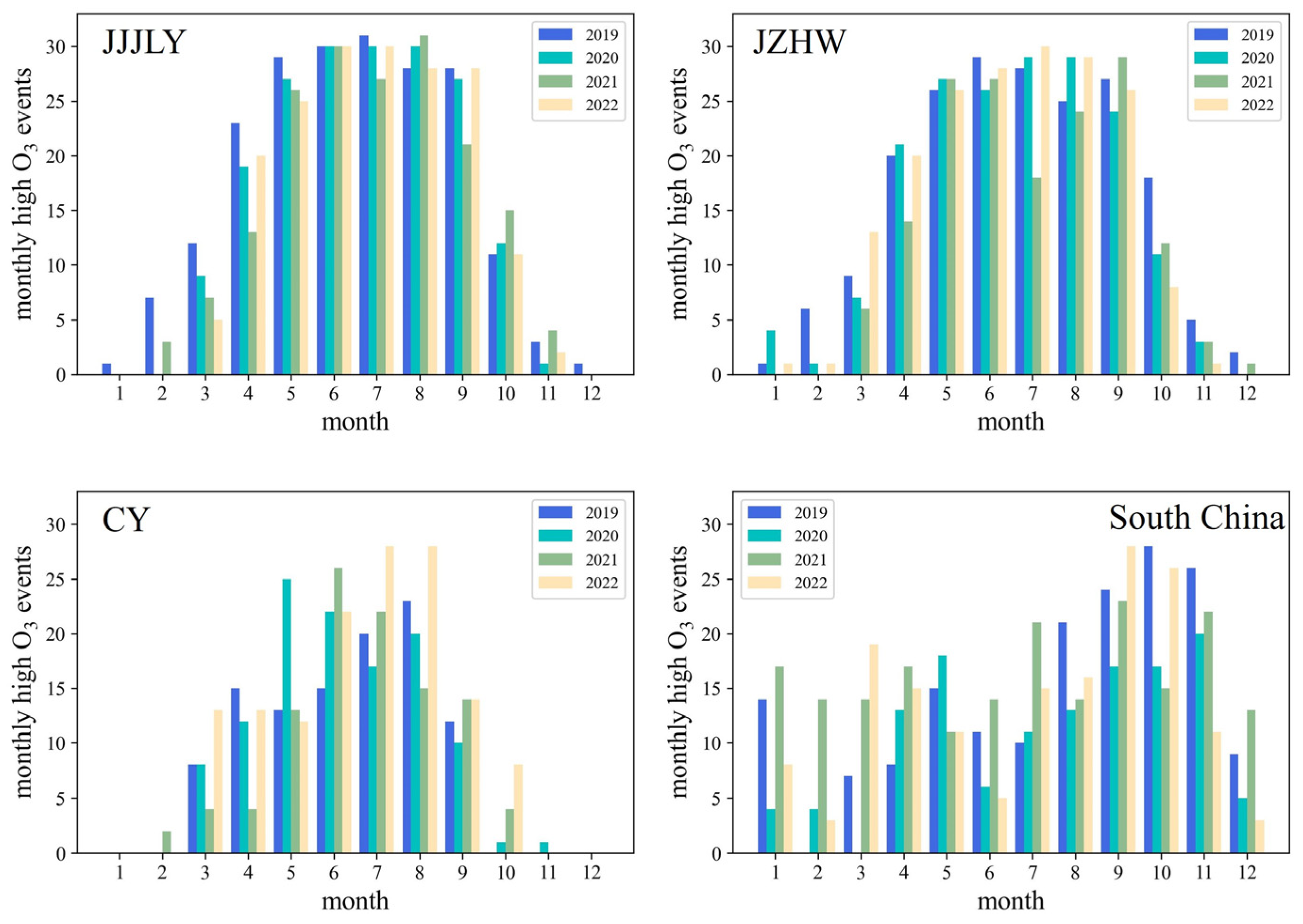




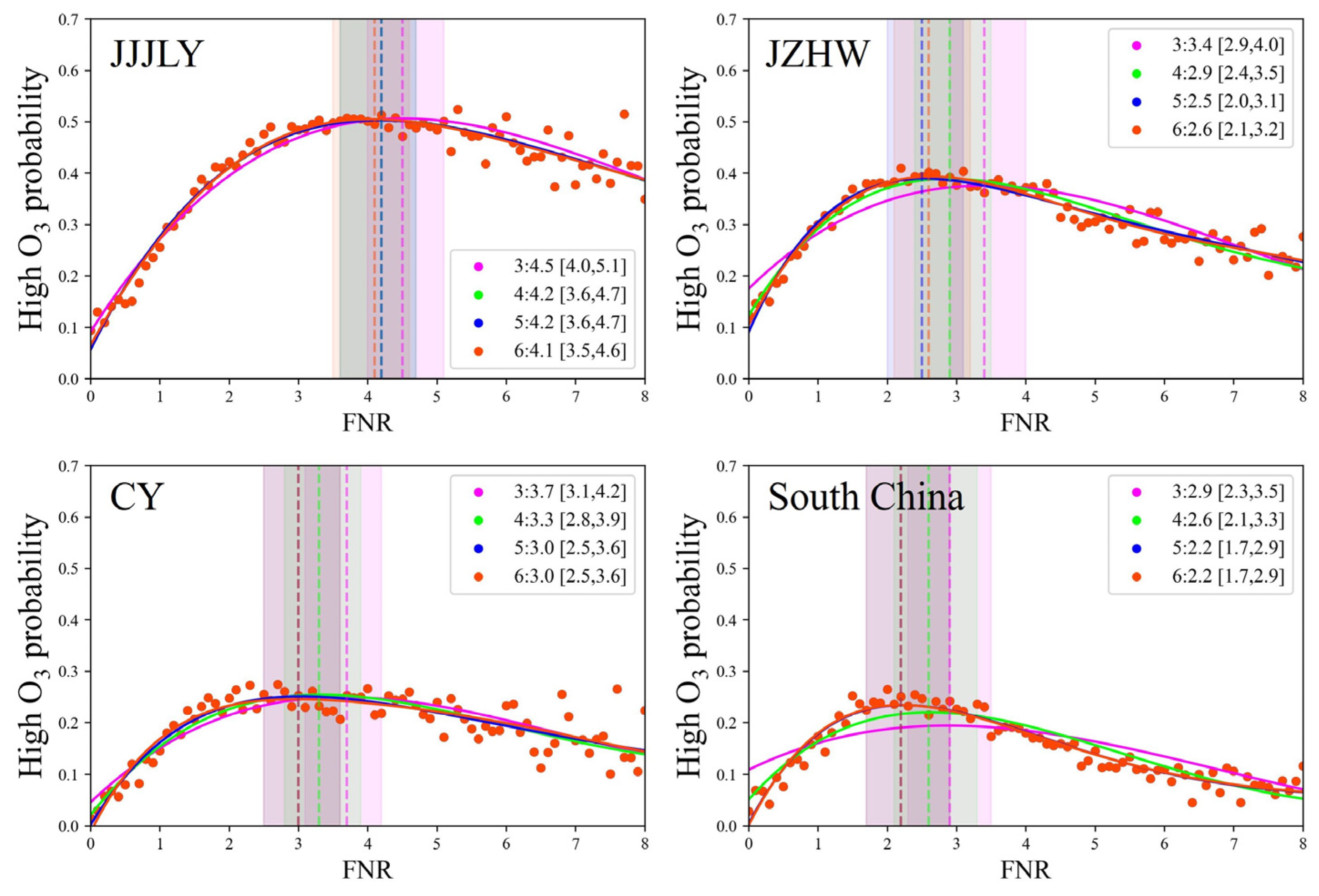
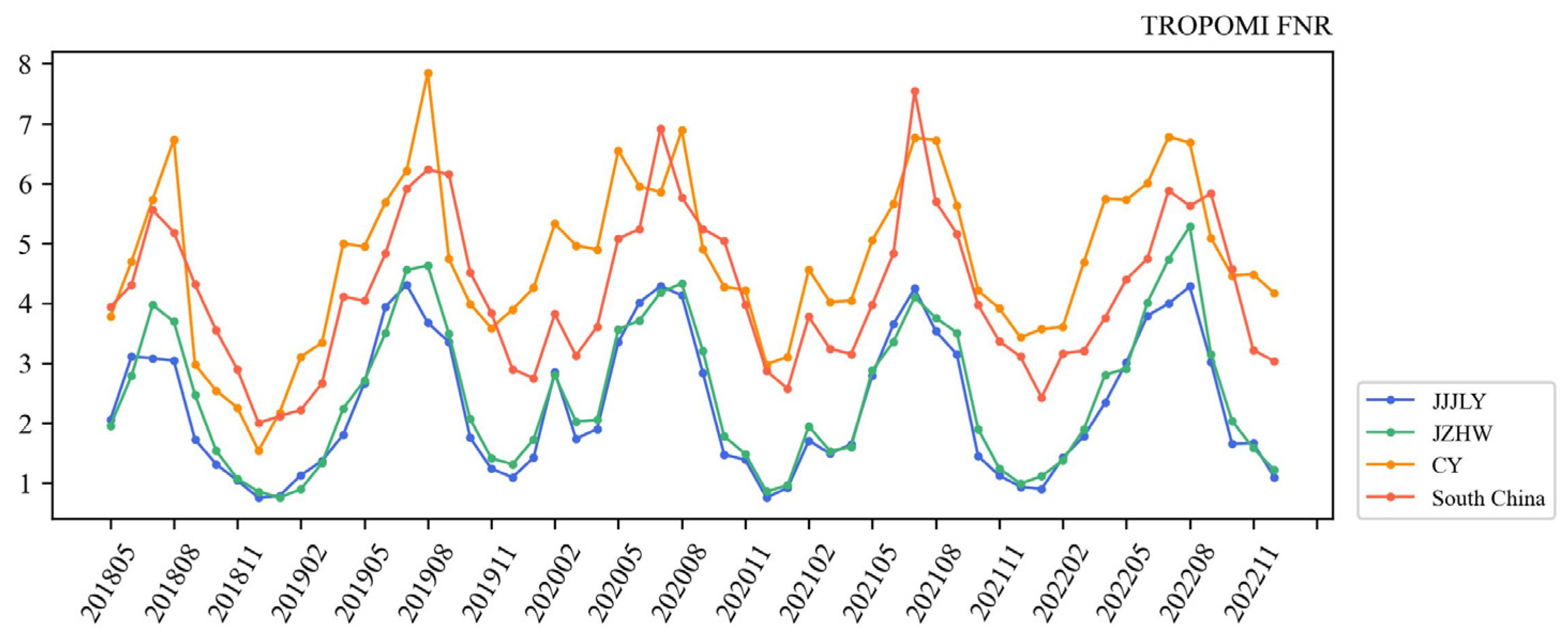
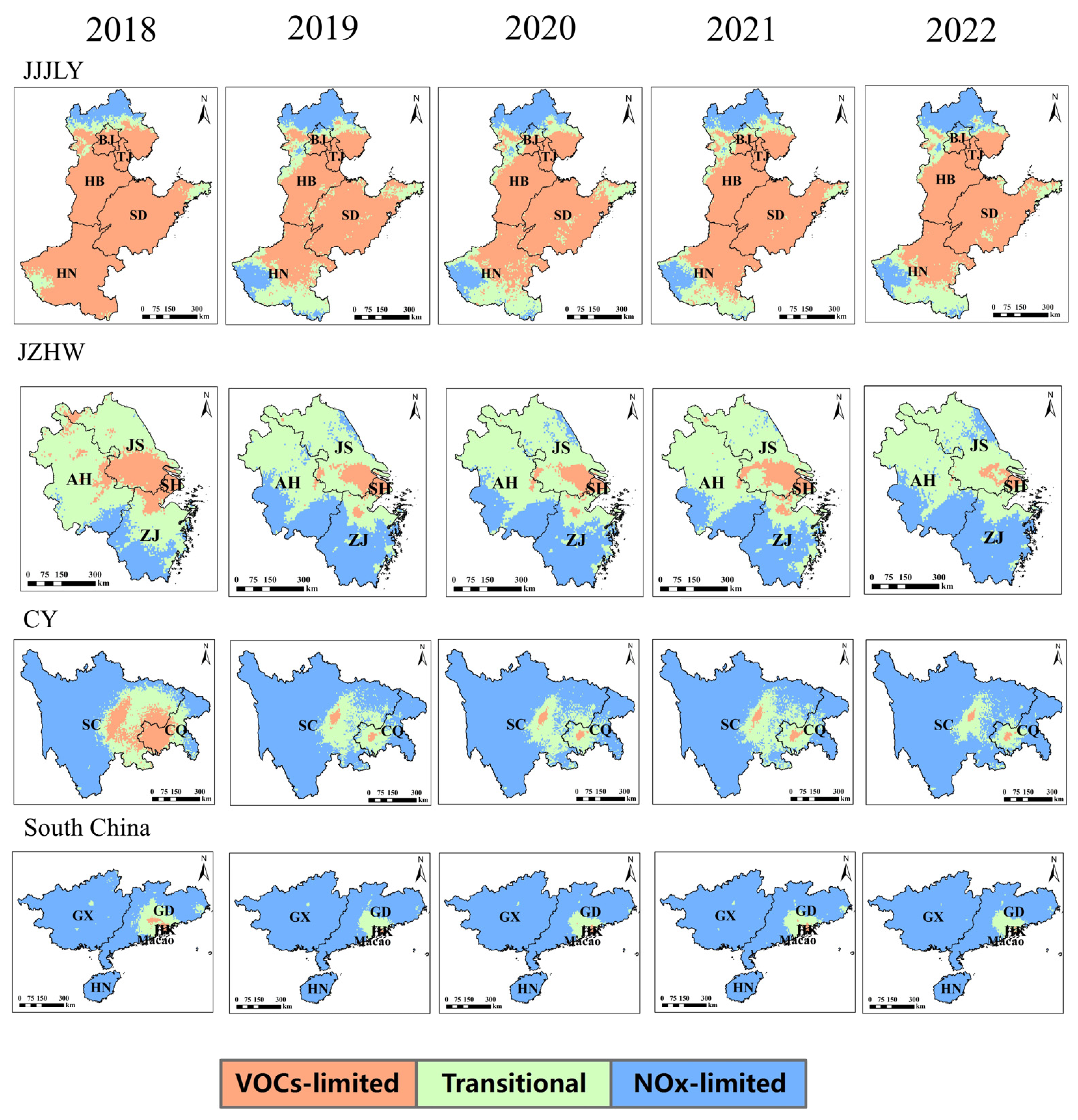
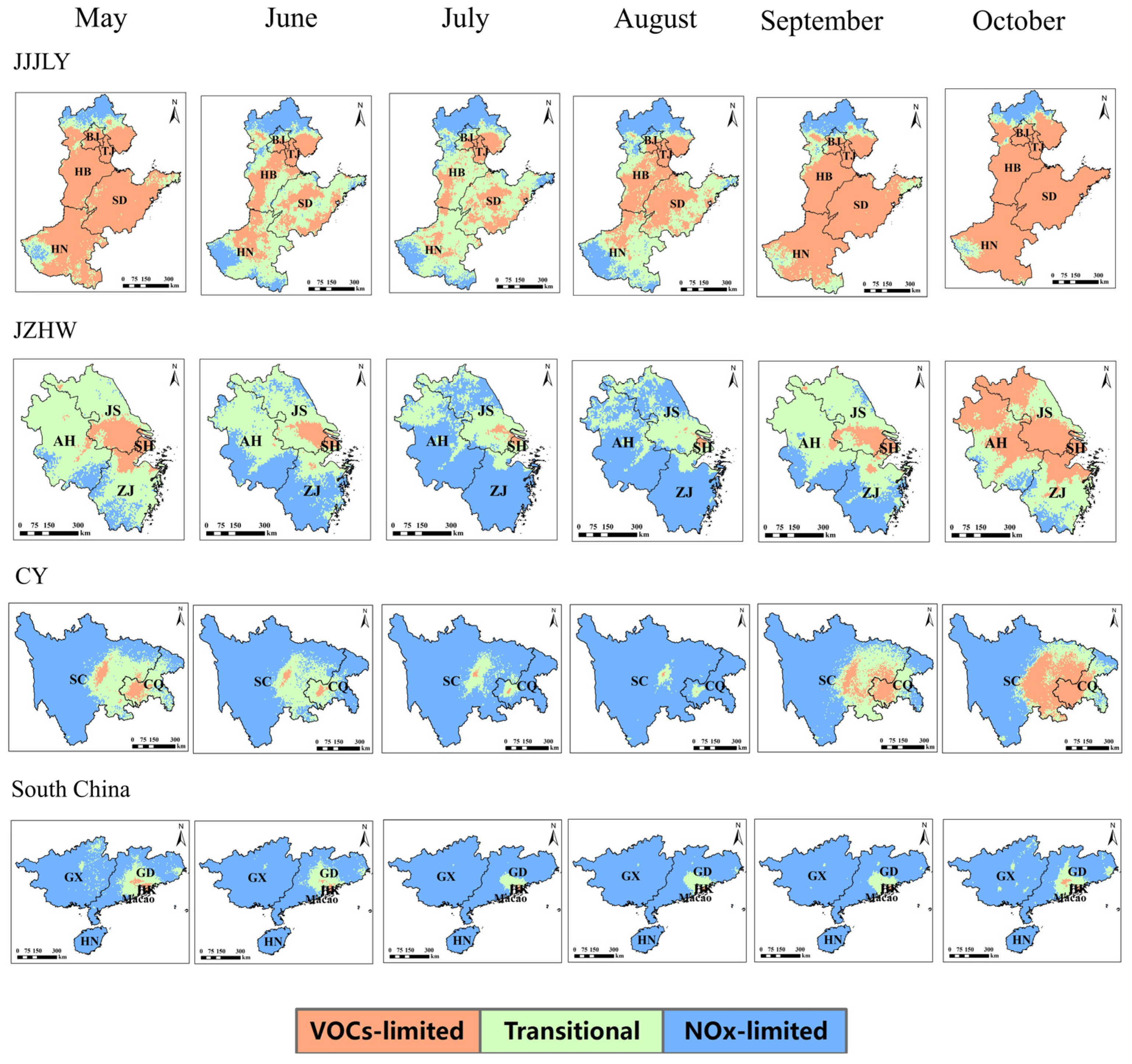
Disclaimer/Publisher’s Note: The statements, opinions and data contained in all publications are solely those of the individual author(s) and contributor(s) and not of MDPI and/or the editor(s). MDPI and/or the editor(s) disclaim responsibility for any injury to people or property resulting from any ideas, methods, instructions or products referred to in the content. |
© 2024 by the authors. Licensee MDPI, Basel, Switzerland. This article is an open access article distributed under the terms and conditions of the Creative Commons Attribution (CC BY) license (https://creativecommons.org/licenses/by/4.0/).
Share and Cite
Li, Y.; Yu, C.; Tao, J.; Lu, X.; Chen, L. Analysis of Ozone Formation Sensitivity in Chinese Representative Regions Using Satellite and Ground-Based Data. Remote Sens. 2024, 16, 316. https://doi.org/10.3390/rs16020316
Li Y, Yu C, Tao J, Lu X, Chen L. Analysis of Ozone Formation Sensitivity in Chinese Representative Regions Using Satellite and Ground-Based Data. Remote Sensing. 2024; 16(2):316. https://doi.org/10.3390/rs16020316
Chicago/Turabian StyleLi, Yichen, Chao Yu, Jinhua Tao, Xiaoyan Lu, and Liangfu Chen. 2024. "Analysis of Ozone Formation Sensitivity in Chinese Representative Regions Using Satellite and Ground-Based Data" Remote Sensing 16, no. 2: 316. https://doi.org/10.3390/rs16020316
APA StyleLi, Y., Yu, C., Tao, J., Lu, X., & Chen, L. (2024). Analysis of Ozone Formation Sensitivity in Chinese Representative Regions Using Satellite and Ground-Based Data. Remote Sensing, 16(2), 316. https://doi.org/10.3390/rs16020316







